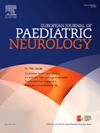ACTN3基因型对杜氏肌营养不良症的预后意义:阿根廷患者队列的研究结果。
IF 2.3
3区 医学
Q3 CLINICAL NEUROLOGY
引用次数: 0
摘要
在DMD患者中存在广泛的表型谱,遗传修饰被认为是这种变异性的假定原因。主要目的是评估阿根廷DMD队列中4种遗传修饰因子和DMD变异位点对疾病严重程度的影响。第二个目的是总结当前的知识状态和测试基因座与DMD表型的关联。两组极端表型(重度/轻度)的患者根据丧失活动能力的年龄来定义。SPP1、LTBP4、CD40和ACTN3的snv进行基因分型,并采用卡方检验或Fisher精确检验比较各组间snv的分布。通过多变量logistic回归评估糖皮质激素治疗、DMD突变位置(近端/远端)和其他基因座的并发效应。此外,我们进行了系统的文献综述,总结和解释了修饰语对各种DMD性状的影响。在我们的队列中,ACTN3-rs1815739是DMD进展的唯一修饰位点。检测到DMD突变和ACTN3之间同时存在破坏性影响,确定了远端变异和ACTN3 tt基因型之间可能存在相互作用,这需要在更大的队列中进行验证。当有显著差异时,系统评价显示结果一致。使用极端DMD表型组是识别疾病严重程度风险位点的一种创新方法。DMD突变位点与ACTN3之间的相互作用如果得到证实,将有助于避免临床试验研究队列的混淆因素。最后,本报告的主要亮点是首次对阿根廷和拉丁美洲人口进行的研究。本文章由计算机程序翻译,如有差异,请以英文原文为准。
Prognostic significance of ACTN3 genotype in Duchenne muscular dystrophy: Findings from an Argentine patient cohort
A wide phenotypic spectrum exists among DMD patients, with genetic modifiers seen as a putative cause of this variability. The main aim was to evaluate the effect of 4 genetic modifiers and the location of DMD variants on disease severity in a DMD Argentine cohort. A secondary objective was to provide a summary of the current state of knowledge and association of the tested loci with DMD's phenotype. Two groups of patients with extreme phenotypes (Severe/Mild) were defined based on the age at loss of ambulation. SNVs in SPP1, LTBP4, CD40, and ACTN3 were genotyped, and their distribution was compared between groups using Chi-square or Fisher exact tests. Concurrent effects with glucocorticoids treatment, DMD mutation location (proximal/distal) and the other loci were evaluated by multivariate logistic regression. Additionally, we performed a systematic literature review to summarize and interpret the impact of modifiers on various DMD traits. ACTN3-rs1815739 was the only modifier loci of DMD progression in our cohort. A concurrent damaging effect between DMD mutation and ACTN3 was detected, identifying a possible interaction between distal variants and ACTN3 TT-genotype that need to be validated in a larger cohort. The systematic review showed agreement in the results when significant differences were reported. The employment of extreme DMD phenotypic groups was an innovative approach for identifying risk loci for disease severity. The interaction between DMD mutation location and ACTN3, if confirmed, could help to avoid confounding elements in assembling study cohorts for clinical trials. Finally, this report's major highlight is being the first study conducted on an Argentine and Latin-American population.
求助全文
通过发布文献求助,成功后即可免费获取论文全文。
去求助
来源期刊
CiteScore
6.30
自引率
3.20%
发文量
115
审稿时长
81 days
期刊介绍:
The European Journal of Paediatric Neurology is the Official Journal of the European Paediatric Neurology Society, successor to the long-established European Federation of Child Neurology Societies.
Under the guidance of a prestigious International editorial board, this multi-disciplinary journal publishes exciting clinical and experimental research in this rapidly expanding field. High quality papers written by leading experts encompass all the major diseases including epilepsy, movement disorders, neuromuscular disorders, neurodegenerative disorders and intellectual disability.
Other exciting highlights include articles on brain imaging and neonatal neurology, and the publication of regularly updated tables relating to the main groups of disorders.

 求助内容:
求助内容: 应助结果提醒方式:
应助结果提醒方式:


